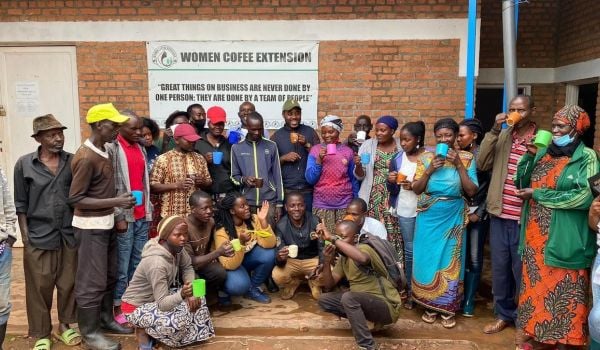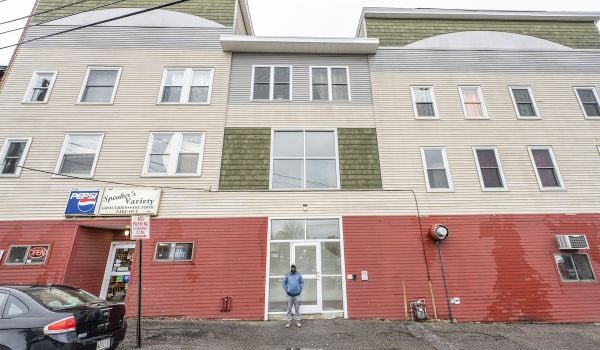In the Los Angeles metro area, white-owned businesses average $528,171 in annual revenue, while black-owned businesses average $82,412. There’s a lot that goes into creating and maintaining that kind of racial disparity.
Some of it is history. Public policies and private practices in the real estate industry combined to segregate Los Angeles, starting in the 1930s. Neighborhoods segregated by race reinforced any de facto segregation in who patronized which small businesses. Factor in racial discrimination making it difficult or impossible to access certain career paths, limiting earning potential for black households — and therefore limiting what they might have spent at black-owned businesses in their neighborhoods. Meanwhile, redlining meant black neighborhoods experienced a long, slow decline in housing and other building stock, leaving them associated with blight and low-value homes and limiting the wealth residents might have otherwise used to invest in their businesses.
All the above and more adds up to white households in the Los Angeles metro area having a current median income of $76,952, while black households have a median income of just $47,157. That’s more than one and a half times more spending power in white neighborhoods than black neighborhoods in Los Angeles. Wealth inequality is even starker — the median net worth of white households in Los Angeles is a hundred times the median net worth of black households. That’s a hundred times more friends and family capital dollars to start or grow businesses in white neighborhoods versus black neighborhoods in Los Angeles.
Now, there is new evidence showing that black business owners — as well as Hispanic business owners — are treated differently than non-Hispanic white business owners when they approach banks for a loan. Using the same “secret shopper” methodology often employed to discover racial discrimination in the housing market, the new research, published this week, shows banks asking more questions and requesting more information up front from black or Hispanic business owners compared to white business owners — even if the black or Hispanic business owners come in with slightly stronger business profiles.
“We know that when it comes to things like denial disparities, from the point of actually applying for a loan, there are disparities by race and gender, but this is really pre-application, what’s the experience of minority-owned businesses in even inquiring about about a bank loan,” says Jesse Van Tol, CEO of the National Community Reinvestment Coalition (NCRC), the national network of bank watchdog and community development groups that commissioned the new research.
It’s the second time that NCRC has done a “secret shopper” test of small business lending. The first test took place in the Baltimore metro area and had similar findings. Both studies came at crucial moments for federal agencies in the process of implementing or tweaking regulations around banks and other small business lenders. The 2017 Baltimore study came out at a time that the Consumer Financial Protection Bureau was taking comments on how to implement a rule around reporting requirements for small-business lenders, a rule that would in theory shed more light on discrimination in lending — a rule that still has not been implemented. This new study could help shape the debate around the modernization of the Community Reinvestment Act. It also comes at a moment where, NCRC hopes, it can help inform the debates and narratives ahead for the 2020 presidential campaign.
“Part of the reason for this is to create a little more awareness and hold politicians accountable for these kinds of statements that they tend to make on the campaign trail around the importance of small business to the economy,” Van Tol says.
For this study, white, black and Hispanic testers each went to 60 different branches of 32 different banks in Los Angeles. Each was briefed in a fictional business with a strong credit history to inquire about a small business loan. The profiles of all testers were sufficiently strong that, on paper, any of the businesses should qualify for a loan. The black and Hispanic testers’ profiles were even slightly better than their white counterparts in terms of income, assets and credit scores. For each test, three matched testers, one black, one Hispanic and one white, visited the same retail bank branch location.
Bank staff were more likely to ask black or Hispanic business owners about their educational backgrounds or credit histories, and they’re more likely to mention the need for personal income tax documents and personal financial statements. In the Los Angeles study, black testers were the only group asked about their education level.
The additional questions bank staff were more likely to ask black or Hispanic business owners up front don’t seem unreasonable at face value, but differences in treatment up front may indicate explicit or implicit racial bias on the part of bank staff, and that bias may lead to racially disparate access to small business loans.
Other studies have shown that people of color are already pre-dispositioned against seeking out credit from banks or other lenders because of previous personal or family experiences with predatory financial practices. These slight differences in treatment, while the might seem minor, may matter a lot in terms of encouraging or discouraging people of color to seek out small business loans. But there’s no way to know for sure without more robust data on small business applications and approvals.
In the home lending market, bank watchdogs and regulators alike use “secret shopper” testing methodology to uncover and verify violations of the Fair Housing Act or the Equal Credit Opportunity Act. But findings from secret shopper studies in home lending carry weight because there is robust data on the end result of borrower-lender interactions. The Home Mortgage Disclosure Act (HMDA) of 1975 requires all home mortgage lenders, including non-bank lenders, to annually disclose detailed data on all home mortgage activity, including applications that were denied. Loan-level data from 2018 just came out at the end of August. Information released include the income, gender, race and ethnicity of the applicants, whether the loan was for purchase or improvement or refinancing, census tract of the property, whether the application was approved, which lender received the application, and more. HMDA data makes possible investigations like the landmark 2018 Reveal investigation that showed banks were still denying loans to people of color at higher rates than white applicants.
Federal regulators do not collect similar data for small business lending, even though they have the power to do so. The Dodd-Frank Act of 2010 contained a provision known as Section 1071, which gave the Consumer Financial Protection Bureau the authority to collect and disseminate data on the demographics of small business lending by banks as well as other types of financial institutions. Nearly ten years since Dodd-Frank became law, the bureau has yet to implement Section 1071. Some lenders have expressed concern about Section 1071, citing the burden of reporting requirements.
The first NCRC secret shopper study of small business lending came out at the end of 2017, during a period when the bureau was collecting comments from the public on how to implement the law.
This second secret shopper study of small business lending, funded by the W.K. Kellogg Foundation, comes at a time when federal regulators are now re-evaluating regulations around the Community Reinvestment Act (CRA) of 1977, which says banks have a continuing and affirmative obligation to help meet the credit needs of the local communities in which they are chartered, including low-income communities.
Under current CRA regulations, banks report the dollar amount and total number of loans to businesses located in low- to moderate-income census tracts with revenues of up to $1 million. Joseph Otting, who as Comptroller of the Currency leads one of the agencies tasked with CRA examination and enforcement, has expressed his desire to raise that threshold, which was set in 1995. Advocates like Van Tol are concerned that raising this threshold will pull up the ladder and encourage banks to be even less interested in businesses owned by people of color.
“We know that businesses owned by people of color or businesses owned by women tend to be smaller revenue sizes in general,” Van Tol says.
The disparity is even larger in other big cities besides Los Angeles. In Houston, white-owned businesses average $1.5 million in annual revenues, while black-owned businesses average only $52,000.
In Detroit, which is 80 percent black, white-owned businesses average $1.3 million, while black-owned businesses average just $32,600. Over a third (4,491 out of 11,395) of white-owned businesses in Detroit have employees, while barely one percent (765 out of 47,640) black-owned businesses in Detroit do.
Advocates, researchers and journalists alike would love to study why those numbers are what they are, and what the role of discrimination in small business lending might have to do with why black-owned businesses are so much smaller on average than white-owned businesses, but it’s difficult to analyze without the same level of data as there is in home mortgage lending.
Speaking with community advocates in New York City last month, Comptroller Otting expressed his view, shared by many in the banking industry, that the CRA was intended to encourage banks to make loans in the same communities where they hold deposits. In that discussion, Otting conceded that “HMDA-type data” for small business lending would be helpful for CRA enforcement.
Besides the issue of racial bias uncovered by the “secret shopper” part of the study, the NCRC study also found that banks are lending less often to small businesses, even as they continue growing in deposits. Researchers also looked at publicly available banking sector and overall small business lending data in Atlanta, Houston, Los Angeles, Milwaukee, New York City, Philadelphia and Washington, D.C. They uncovered a troubling dissonance: With one exception, small business lending from banks has declined since 2008 even as bank deposits have continued to grow in these cities. Houston is the one exception. There, small business lending has grown only 19 percent while bank deposits have doubled.
It’s true that non-bank lenders, including online lenders, are likely replacing banks as they retreat from small business lending, but that comes at the cost of typically higher interest rates, and still doesn’t necessarily guarantee that business owners of every demographic are getting equal access to small business loans. But now even Lending Club, one of the most prominent online lending platforms, is retreating from small business loans.
“Think about anytime that there’s an election, presidential or otherwise, you have policy makers talking about the importance of small business,” Van Tol says. “And yet, when you think about small business lending markets, they’re not well understood.”
EDITOR’S NOTE: This story originally misstated that the first NCRC mystery shopper test took place in Philadelphia. It was Baltimore, and we’ve corrected the story.
This article is part of The Bottom Line, a series exploring scalable solutions for problems related to affordability, inclusive economic growth and access to capital. Click here to subscribe to our Bottom Line newsletter.

Oscar is Next City's senior economic justice correspondent. He previously served as Next City’s editor from 2018-2019, and was a Next City Equitable Cities Fellow from 2015-2016. Since 2011, Oscar has covered community development finance, community banking, impact investing, economic development, housing and more for media outlets such as Shelterforce, B Magazine, Impact Alpha and Fast Company.
Follow Oscar .(JavaScript must be enabled to view this email address)







_920_518_600_350_80_s_c1.jpg)










